After an embarrassing 2-0 defeat to the Czech Republic in the Round of 16 of Euro 2020, Frank de Boer was relieved of his duties as the manager of the Dutch national team.
His appointment was one shrouded in controversy back at the end of September 2020 and many fans and pundits believed it was the wrong appointment.
Before he was appointed a year ago, the former Manchester United and Ajax head coach Louis van Gaal was one of the favourites to succeed Ronald Koeman, who left to take over as the manager of FC Barcelona, but the legendary Dutch coach opted against doing so.
Nonetheless, less than a year later, following de Boer’s sacking, van Gaal was back at the helm of the national team for his third stint since the turn of the 21st Century.
The 70-year-old has been in charge for three games so far, winning two and drawing his debut match against Erling Haaland’s Norway. The Oranje have looked really solid and have adapted to van Gaal’s philosophy quite well, one which is built on positional play and ball retention as well as high pressing.
This article will be a tactical analysis of the Netherlands under van Gaal in the form of a team scout report. It will be an analysis of the tactics used by the manager from his opening three games in charge, solely focusing in detail on how the team set-up whilst in possession of the ball.
Formation and starting XI
Van Gaal was last in charge of the national team back in 2014 when he coached the side to a third-place finish in the World Cup held in Brazil. The philosopher deployed a 4-3-3/4-1-4-1 for the most part during the qualification phases of the 2014 World Cup but switched to a 5-2-3 for the actual tournament.
One of the main reasons for this was because of the loss of Kevin Strootman through injury and so van Gaal believed that a back five was the correct way to get a rather weakened Dutch team to perform.
This time around though, the Netherlands have played with a 4-3-3 again as van Gaal now has the players at his disposal. From just three games in charge of the team, it is very evident what he believes is his best starting eleven, including Frenkie de Jong as the fulcrum in the ‘6’ position.
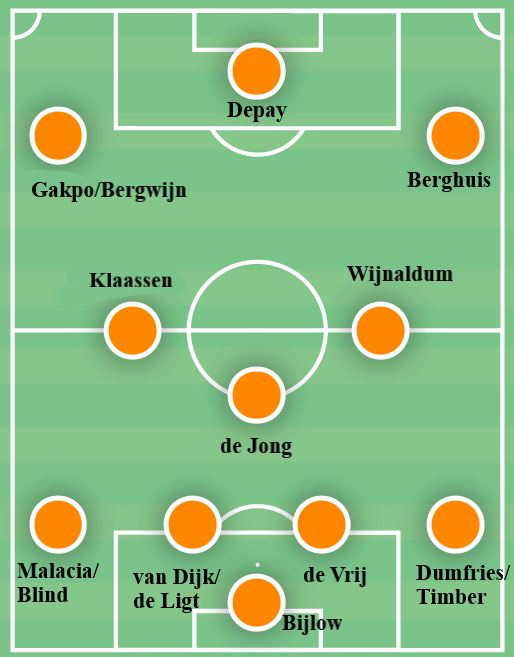
Van Gaal handed a debut to 23-year-old goalkeeper Justin Bijlow in a 1-1 draw with Norway last week. The Feyenoord number one is now seemingly the manager’s first-choice in goal having started in all three games so far.
In defence, van Gaal has fluctuated between who his starting fullbacks should be. Daley Blind and Tyrell Malacia have been utilised at left-back while Denzel Dumfries and Jurriën Timber have been fighting for the right-back berth, although it seems as though van Gaal prefers Dumfries and Blind.
As already stated, Frenkie de Jong has operated as the ‘6’ in de Jong’s 4-3-3 and has been supported by Davy Klaassen and Georginio Wijnaldum as the two more advanced central midfielders.
The manager has also been rather consistent in his front three, deploying Memphis Depay – the man he bought while in charge of Man United – down the middle in somewhat of a false 9 role.
Depay has mostly been flanked by Cody Gakpo off the left and Steven Berghuis on the right of the three, but Steven Bergwijn took the place of Gakpo in the most recent match – a 6-1 trouncing of Turkey.
Build-up play and progression phase
It has become common knowledge by now that van Gaal’s philosophy of football is built around possession and building up through the thirds of the pitch using positional play with plenty of players occupying areas between the lines.
Across his three games in charge so far, the Netherlands have averaged 68.11 percent ball possession and the coach has continued his predecessors’ styles of emphasis playing out from the back.
When the Netherlands play out from the goalkeeper, the two centre-backs in the 4-3-3 split wide and allow the goalkeeper to act almost as a third centre-back. The fullbacks push up high and wide outside the box while the ‘6’ drops into space in front of the box to act as a progressive passing option throughout the opposition’s first line of pressure.
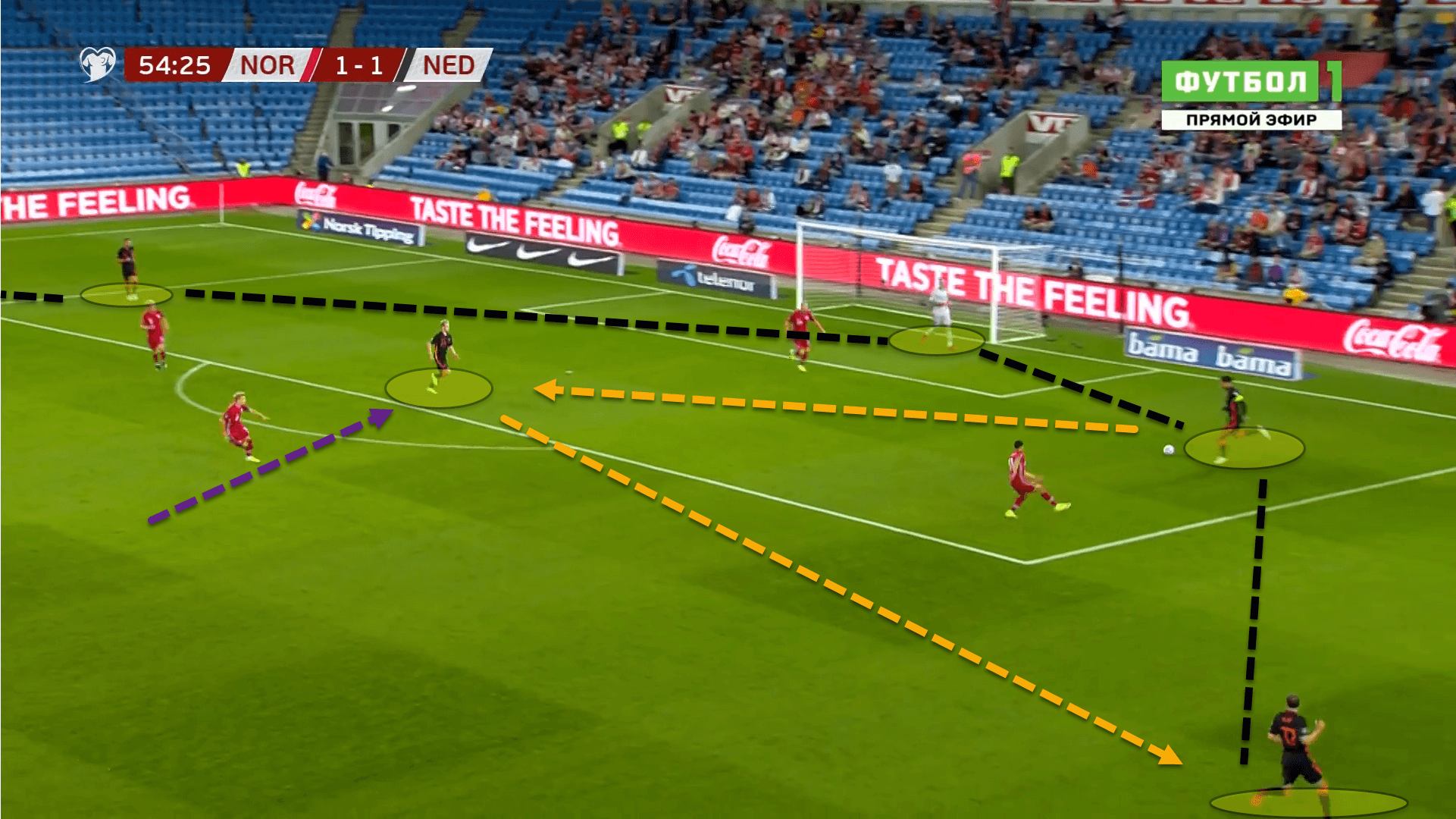
The Netherlands actively seeks ways to play through the central areas when playing out from the back but sometimes the opposition’s press makes it increasingly difficult to do so. Van Gaal’s have been equally adept at playing to the fullbacks as a way of progressing the ball further up the pitch and de Jong is often used as a wall pass to get there, as can be seen from the above image.
When the Dutch team reaches the middle third of the pitch against the opposition’s defensive block – otherwise known as the progression phase – their shape does not resemble a set formation, but the players are instructed to constantly look to gain numerical and positional superiority versus the opponent.
At times, in this phase of the attack, de Jong will drop into the backline to create a back three, giving license to the fullbacks to push forward on the flanks.
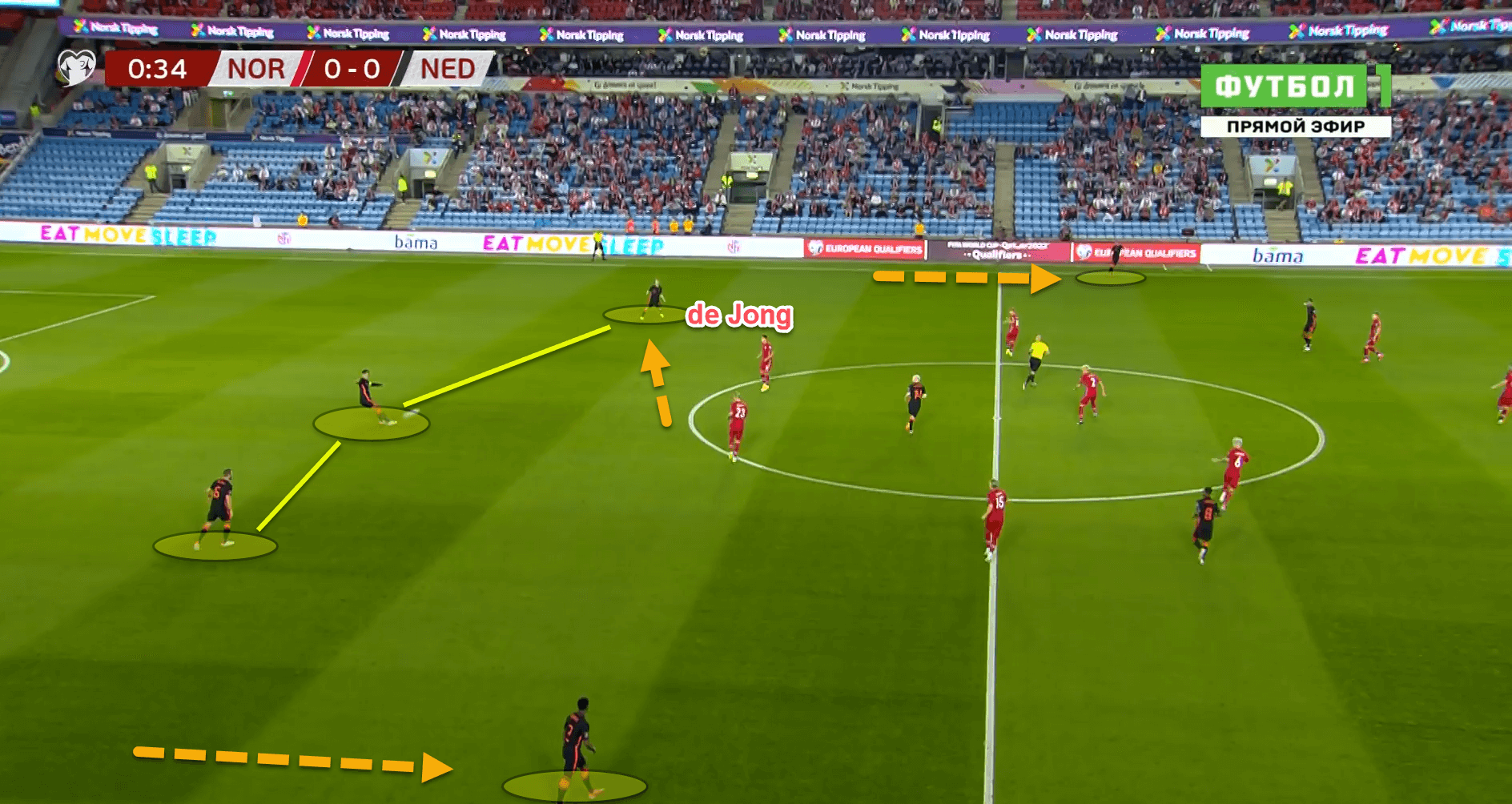
This is mainly done against teams that play with a front two in their first line of pressure. The reason being is that the team in possession can create a 3v2 against the opponent’s front two, gaining numerical superiority and making ball progression easier.
Another way teams look to do this is by keeping one fullback deep as a third centre-back, which allows the midfielders to remain in higher areas.
In the first game against Norway, de Jong constantly dropped as a third centre-back to create this 3v2 but in the second game, at home to Montenegro, van Gaal wanted the Barcelona star to play in a higher position and so tasked his fullbacks with taking turns to stay back.
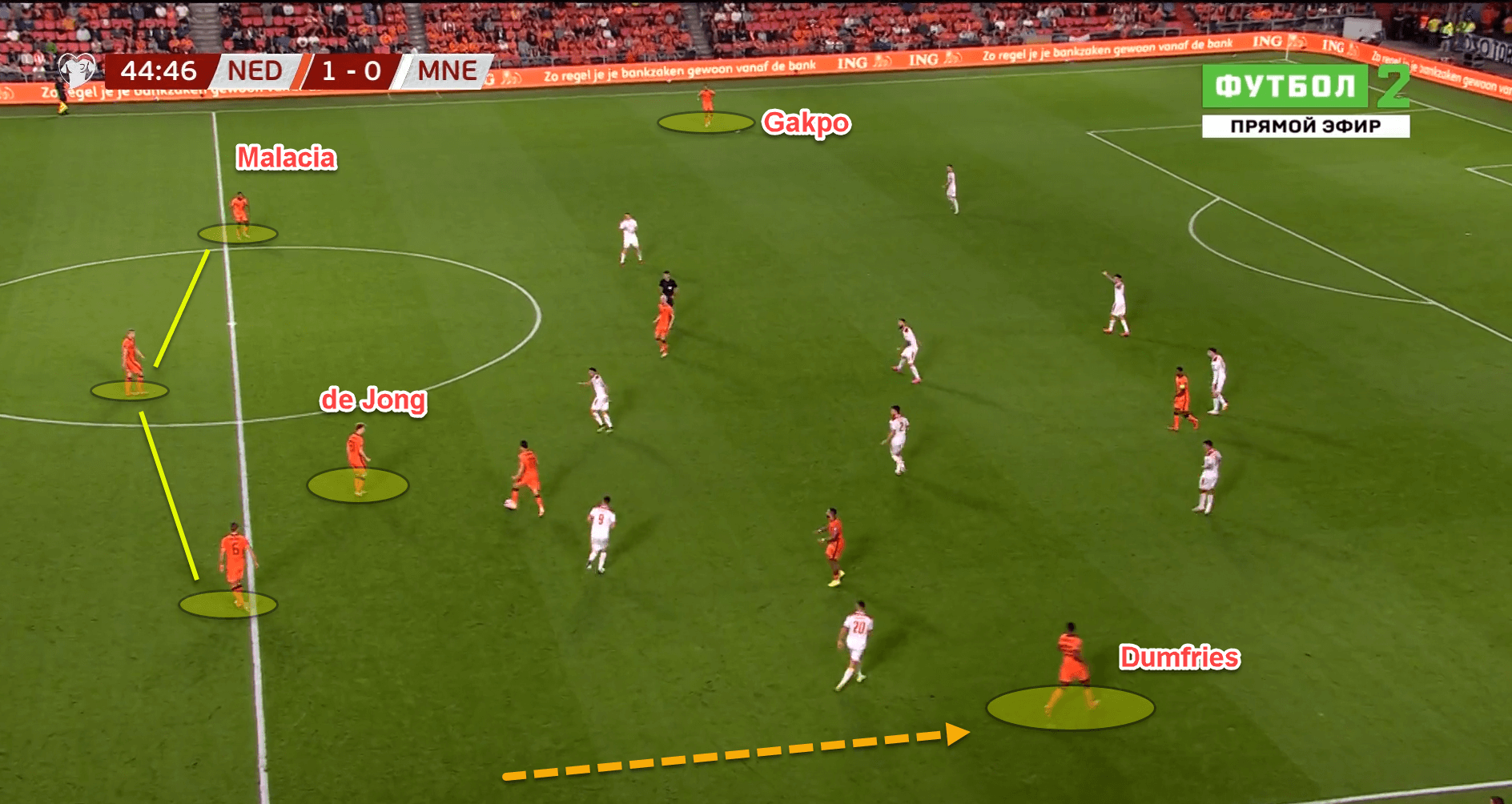
Van Gaal himself spoke about the relationship between his fullbacks before the game and compared his instructions to that of a steering wheel. In a pre-match interview, the 70-year-old coach said:
“The fullbacks have to act like a steering wheel… if Dumfries goes forward, Malacia stays back. If Malacia goes forward, Dumfries stays back.”
This was a perfect analogy by the experienced manager to describe the relationship between his fullbacks. When one pushes high, the other tucks inside into the halfspace and creates a back three.
Looking at the Dutch team’s pass map from van Gaal’s second international game in charge against Montenegro, Malacia and Dumfries’ positioning resembles the ‘steering wheel’ relationship spoken about by the manager.
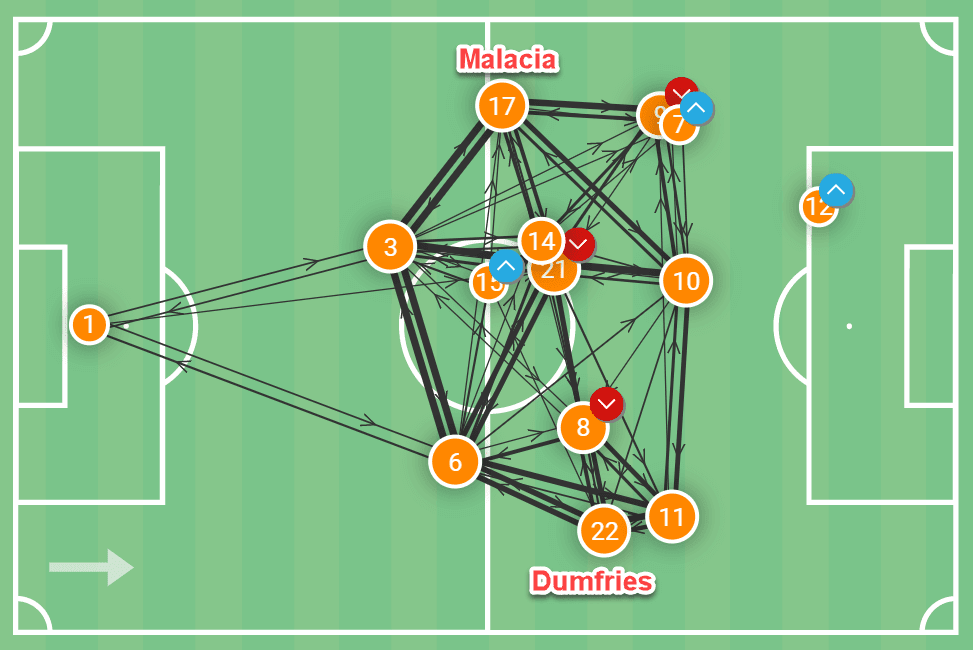
Malacia remained back a lot more than Dumfries in this match and the team’s overall shape looks more similar to a back three as opposed to a back four.
It must also be noted how high de Jong’s positioning is. Having one fullback tuck inside and form a back three instead of de Jong dropping into the first line allows the Barcelona midfielder to play in higher areas of the pitch, which arguably allows him to express himself better further up the field.
Another key component of the Netherlands’ play in this phase under van Gaal is that the Dutch coach wants to have plenty of bodies between the lines with positional superiority. Positional superiority is essentially when a player has taken up a brilliant position between the lines and has both time and space to receive a forward pass.
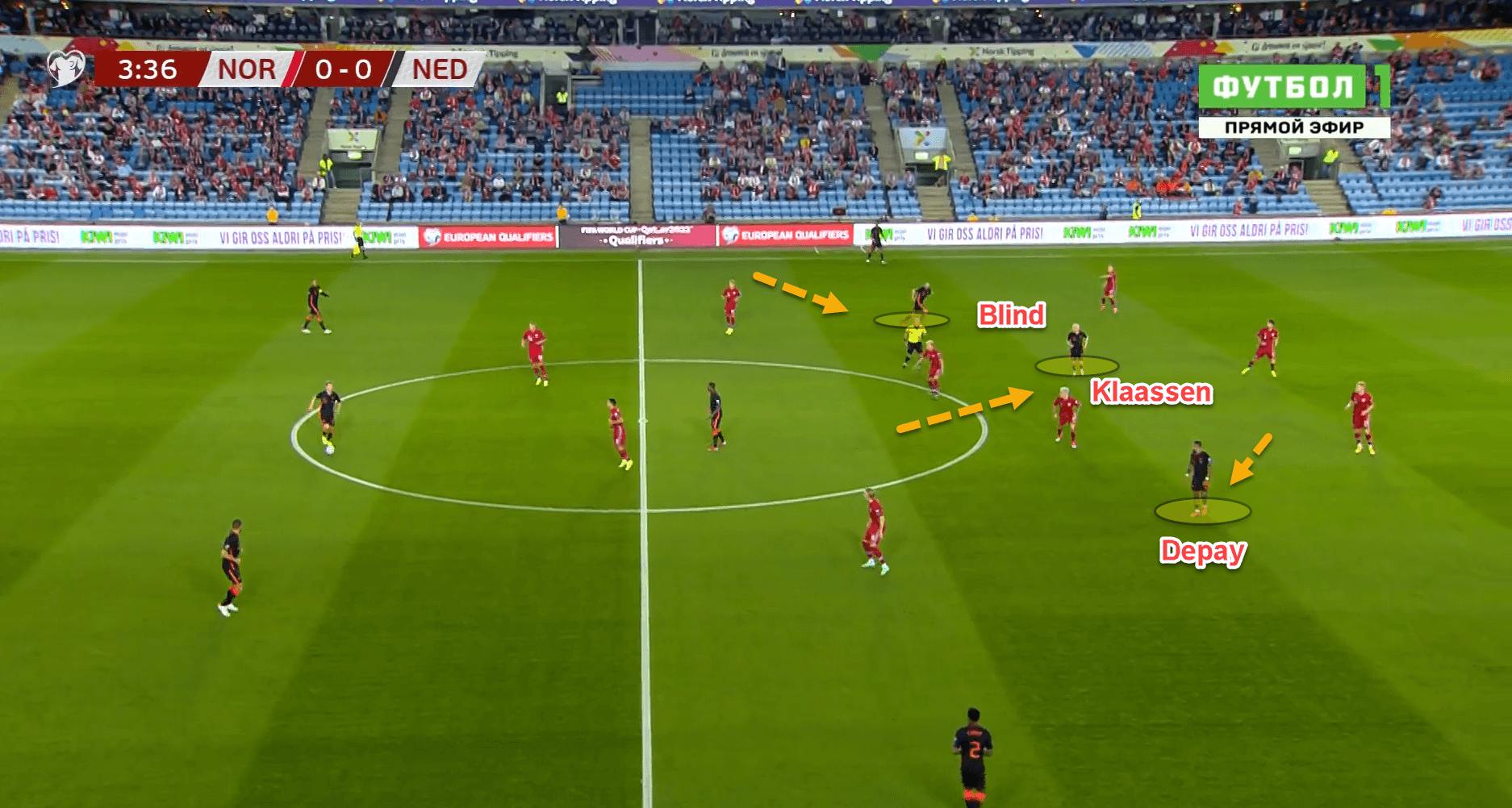
Here, three players have gained positional superiority between Norway’s midfield and backline.
The players in the deeper areas of the pitch will, ideally, be able to get their teammates that are positioned between the lines to receive the ball in areas as such:
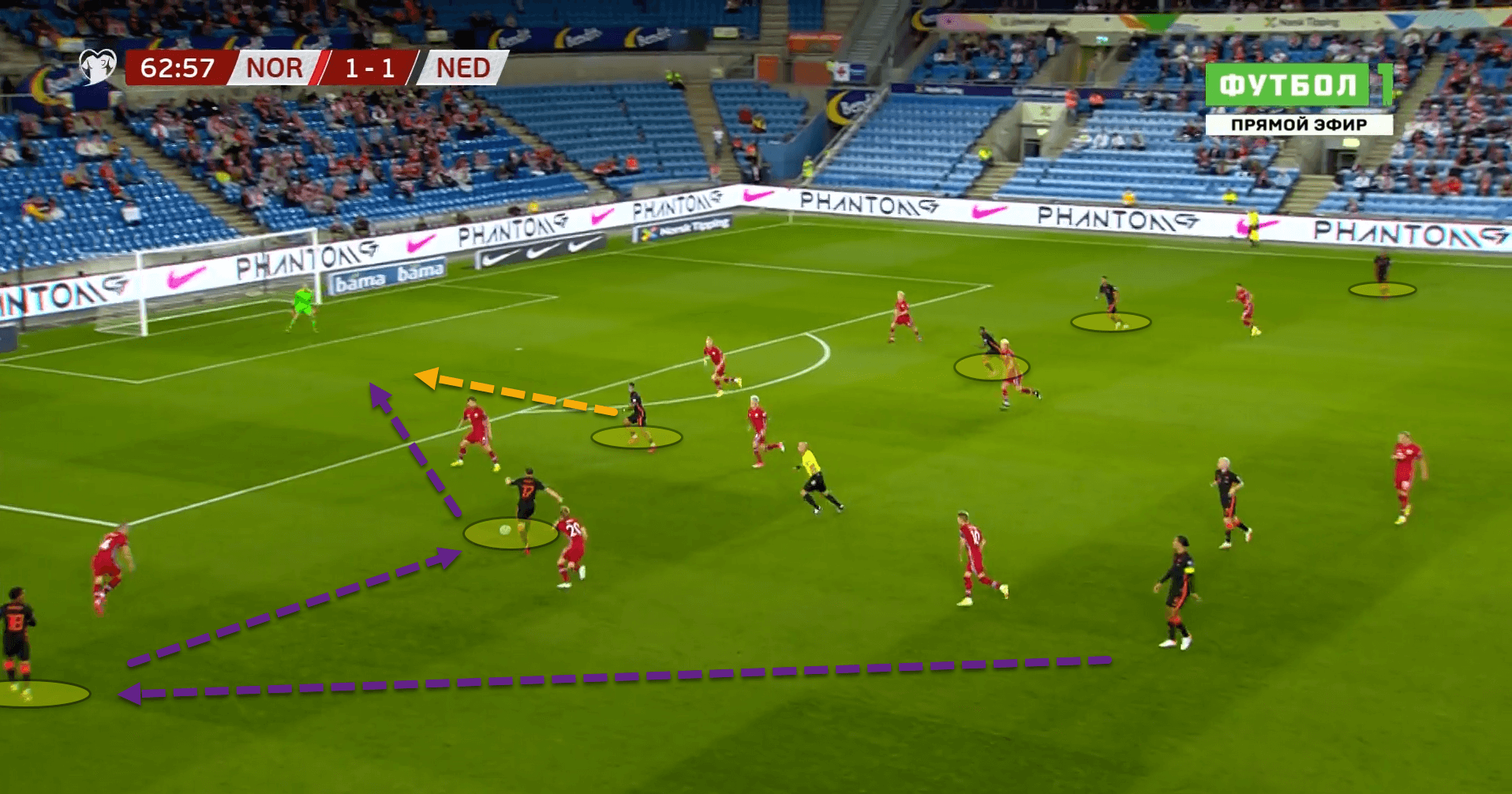
There are no specific players tasked with doing this apart from Memphis Depay who always drops into the halfspaces to receive and create wide overloads in the process. Any player can move into this space providing there are two holding the width on the flanks, three in the backline, and one player in the space behind the opposition’s first line of pressure.
In the previous image, Blind inverted into the left halfspace and occupied a position between the lines while Gakpo maintained his post on the left. However, the pair could have easily interchanged roles also with Gakpo inverting and Blind staying wide:
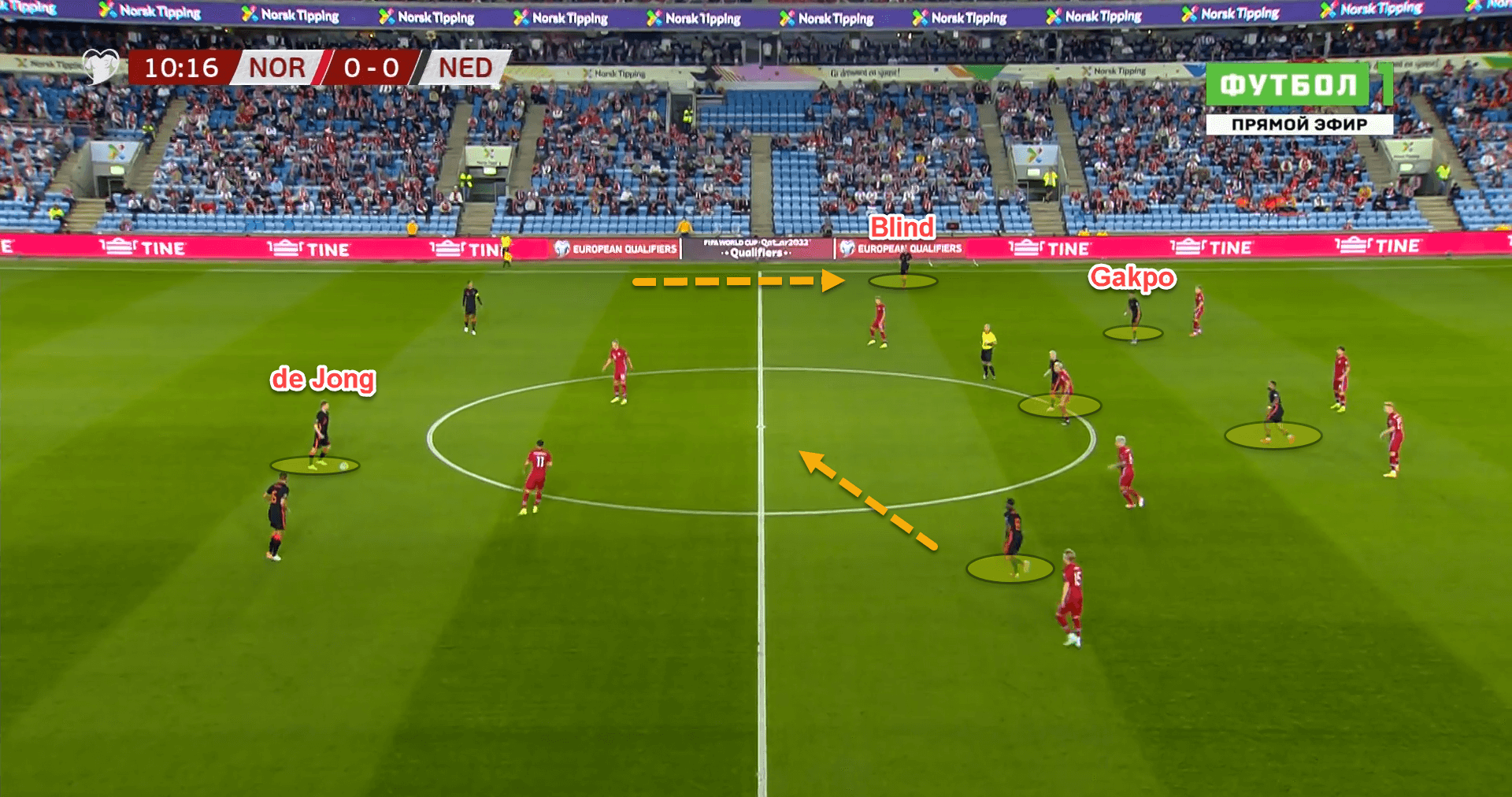
Van Gaal has been quite fluid in his approach with regards to where the players position themselves in advanced areas, providing there are still two players holding the width and three to four players between the lines. Often, the shape will resemble a 3-1-6 or a 3-2-5.
Overloading to isolate
One way teams look to play against the Netherlands is by sitting in a compact 4-4-2 medium-to-low block and denying the Dutch players any space centrally.
As analysed in the previous section in detail, van Gaal wants his players to take up positions between the lines and gain positional superiority. These players will attempt to create good passing angles in order to allow players in deeper areas to have progressive passing options which help the team move the ball into advanced areas.
However, when the area between the lines is compact and narrow, playing centrally to these players can prove to be very difficult, particularly when the defending team is well-drilled.
So, how have the Netherlands looked to get around this? The answer is very simple – by overloading the wide areas.
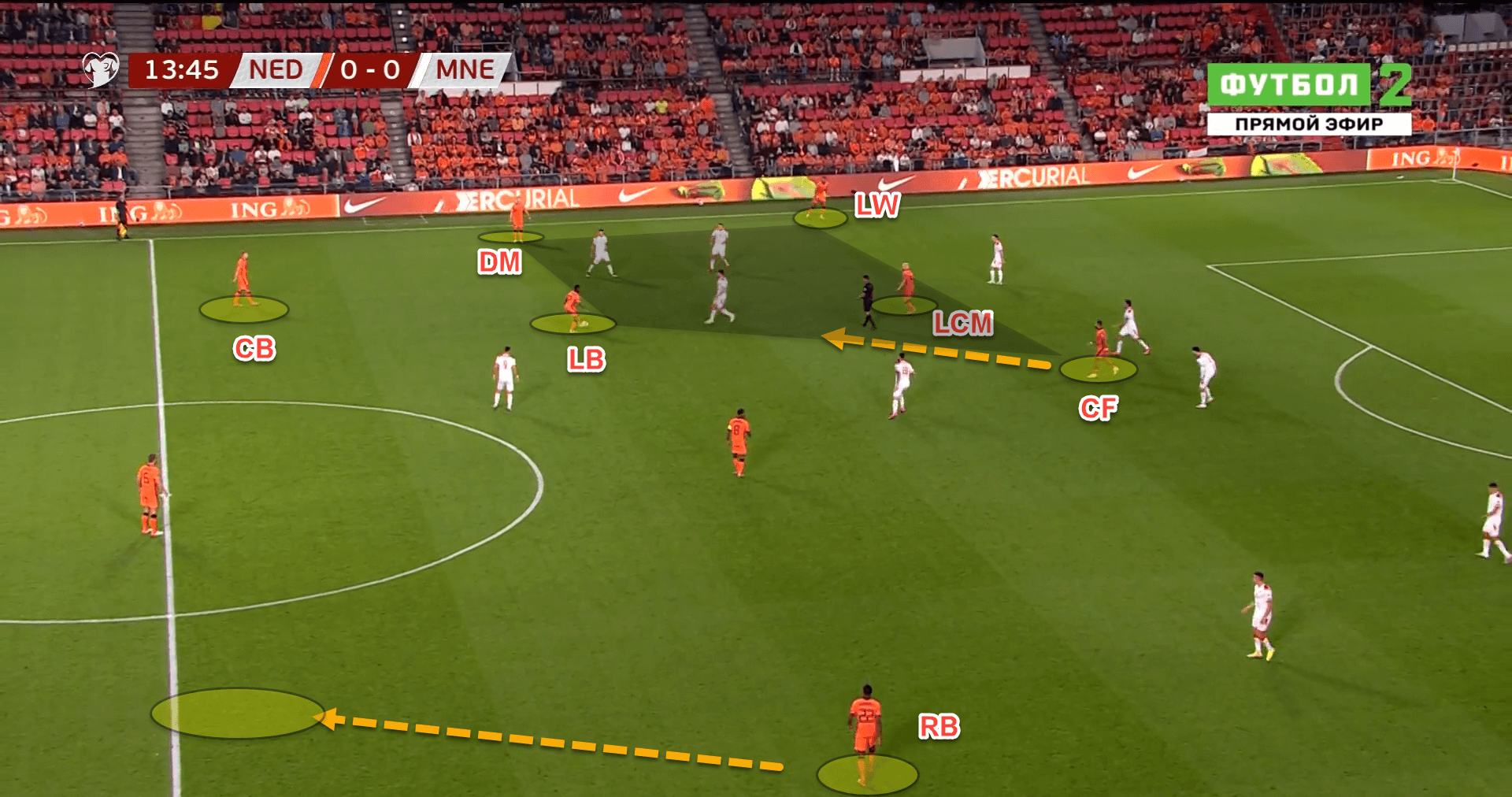
By overloading the wide areas, the Netherlands are essentially ensuring that they have numerical superiority against their opponent on the flank and in the halfspaces.
There are two reasons why van Gaal’s side have found this tactic very useful in their three games so far. Firstly, due to their superior quality, compared to their opponents so far as there are some players playing at an extremely high level of European football currently, the players are able to create combination play and break down the defensive block from the ball-side.
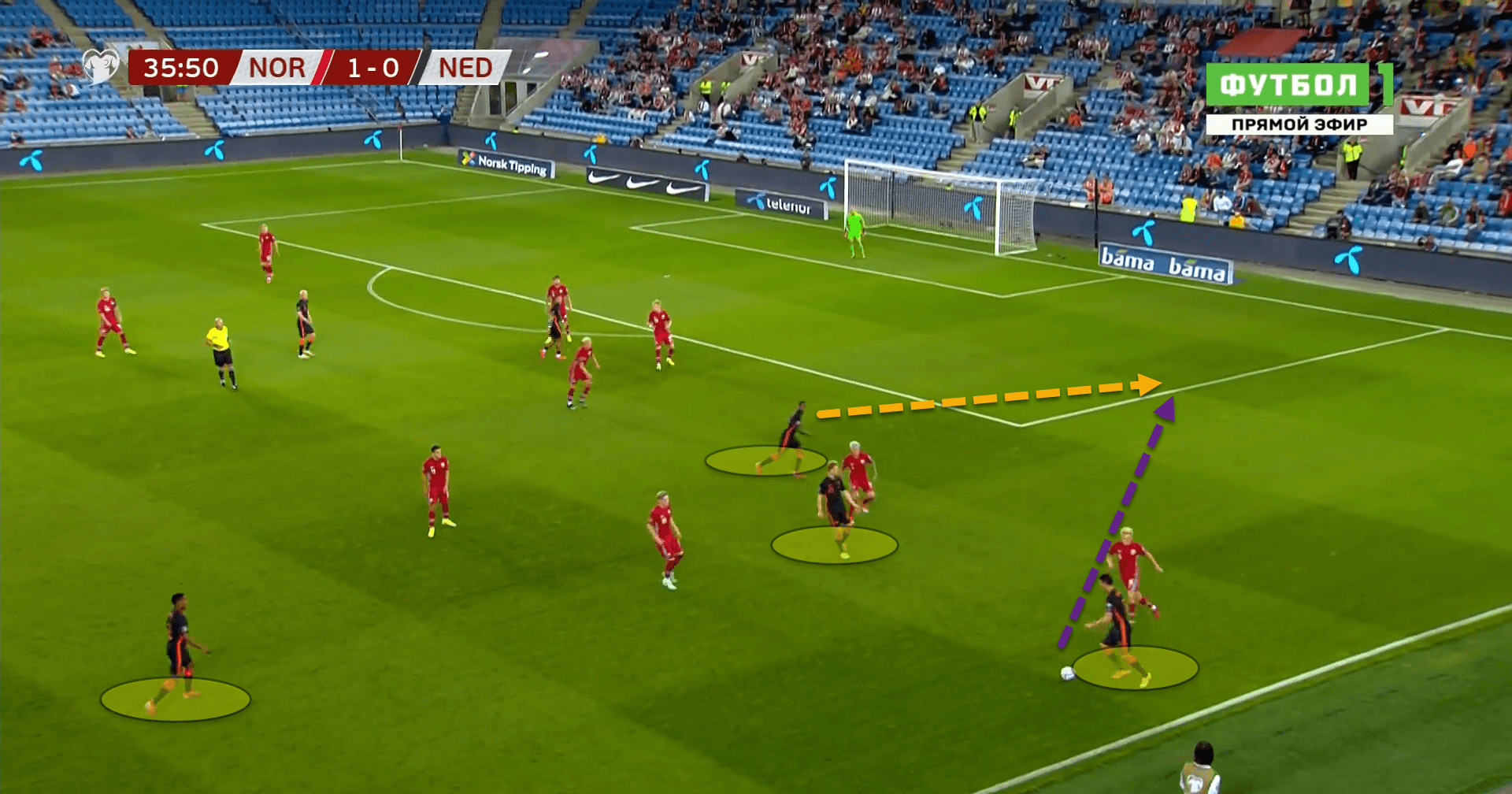
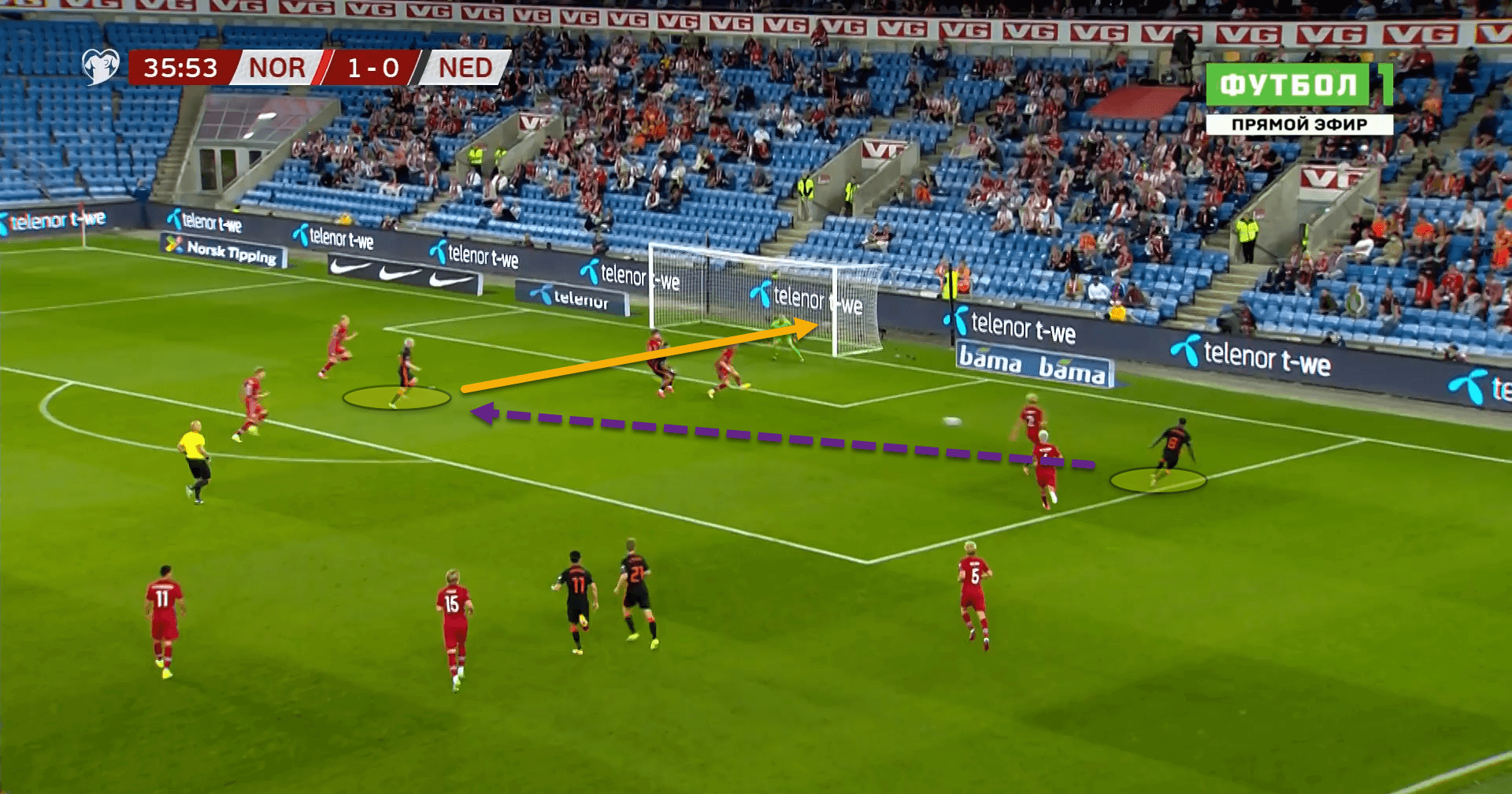
This situation is a perfect example of how well this can work. The Netherlands have overloaded the right flank and Berghuis has managed to find Wijnaldum making a run in behind in the right halfspace.
Wijnaldum latches onto the ball and crosses for Klaassen to poke home the first goal of the third van Gaal era of Dutch football.
However, this is not always guaranteed to work and often the opposition will still prove difficult to break down. When this occurs, the players on the flanks will look to recycle possession to the central defenders, van Dijk and de Vrij, or else de Jong as the ‘6’, to switch the play to the far side.
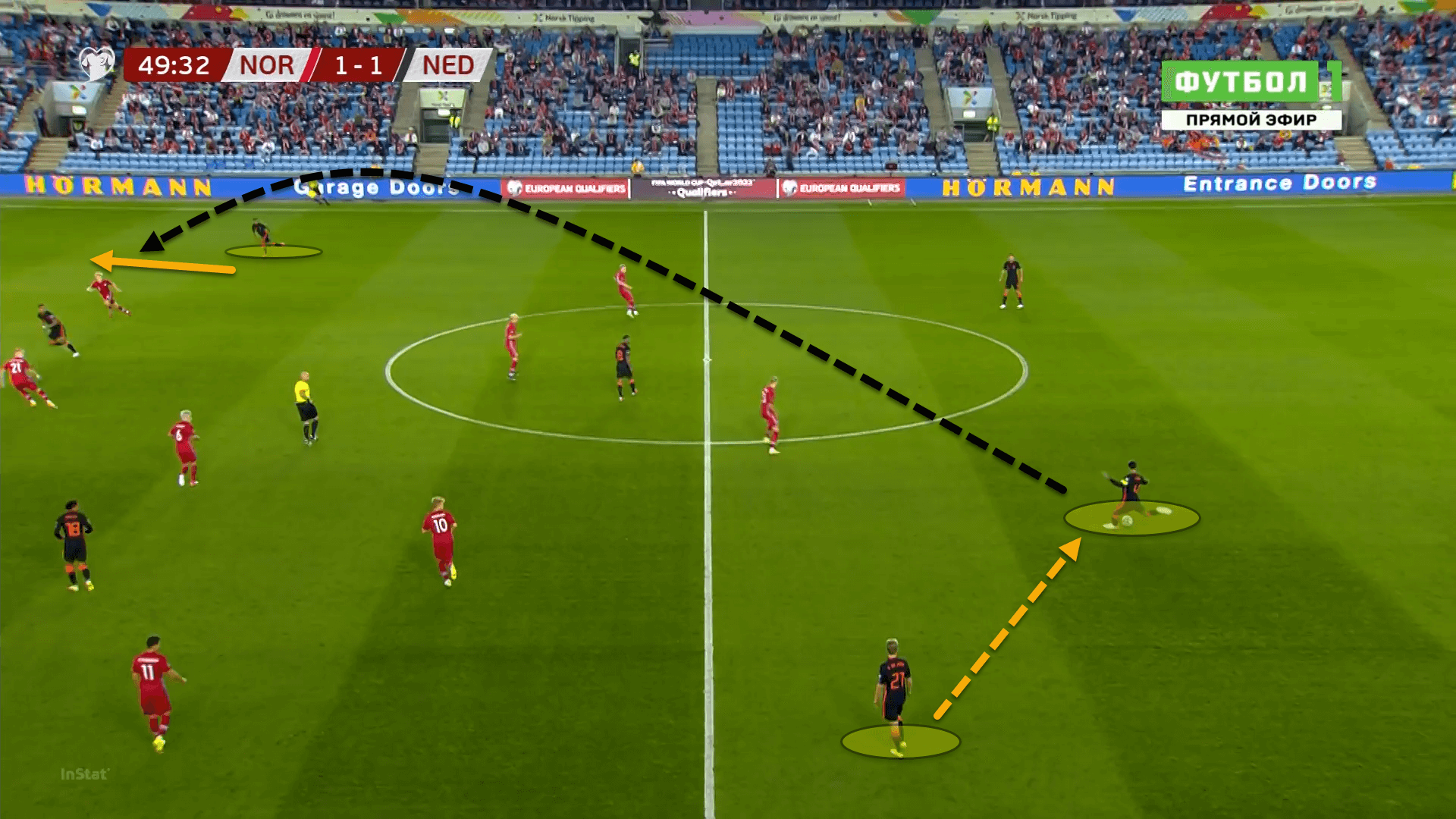
When a team shifts their defensive block across to protect the side being overloaded, it comes at a cost of leaving the ball-far flank exposed. If the ball can be switched quickly enough to a teammate over the far side holding the width, it can cause trouble for the defending team.
This is called ‘overloading to isolate’ and with players such as van Dijk, de Vrij, and de Jong possessing wonderful passing ranges, it makes for a very useful way to try and score, particularly when it occurs in the final third.
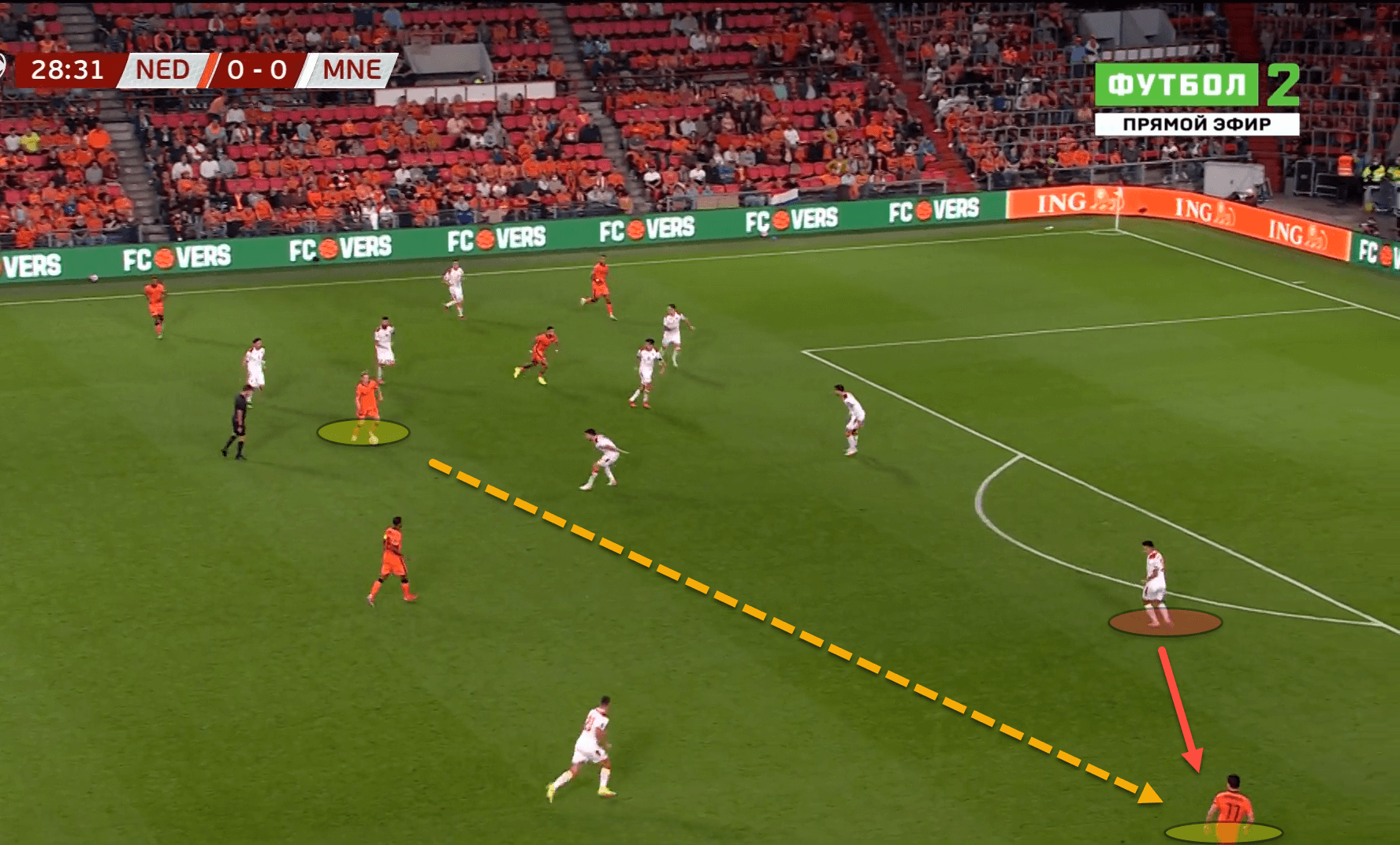
Here, the wide overload on the left flank has allowed Berghuis to receive the ball from de Jong close to goal in a 1v1 situation, an ideal scenario for a winger and a not-so-ideal situation for the defending team.
From the Netherlands’ two games in charge under van Gaal, there have been 130 positional attacks in total. 88 of these 130 attacks came from the wide areas which is 67.7 percent.
Goalscoring
The Netherlands have scored 11 goals already in just three matches under Louis van Gaal and have had a total of 67 shots on goal in the meantime, which is a conversion rate of 16.4 percent.
The vast majority of their shots are coming from inside the penalty area too although the players are not discouraged from taking shots outside the box, particularly Memphis Depay who possesses an innate ability to score from range despite being unsuccessful so far from this scope.
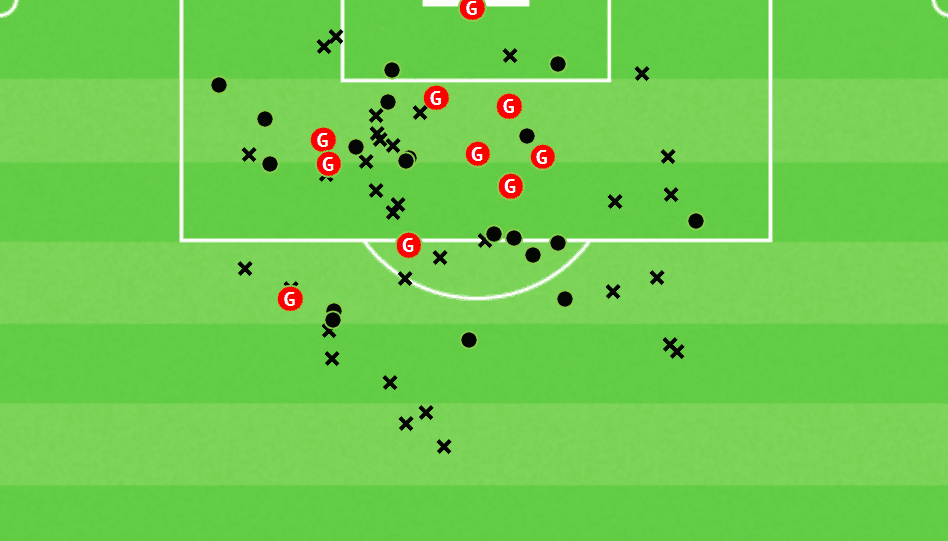
Van Gaal instructs his players to put a lot of crosses into the box and the Dutch team are extremely adept at doing so. There is a specific way that the national side tends to use when looking to create goalscoring chances.
The players on the flanks put early or deep inswinging crosses into the box for players to attack while the Netherlands pile bodies into the area for the cross.
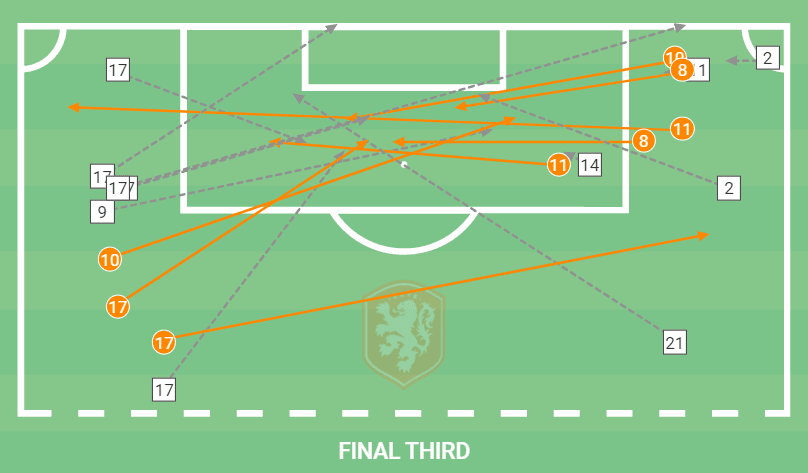
Here are all 19 of the crosses played by van Gaal’s team in his opening game against Norway. Particularly on the left flank, there was clearly an emphasis on playing early crosses to the back post.
By piling bodies into the box, the Netherlands overload the last defender, which is generally the opposition’s fullback, and early inswinging crosses can cause quite a lot of problems for the defending team when this occurs. Depay scored in the game against Turkey from this situation.
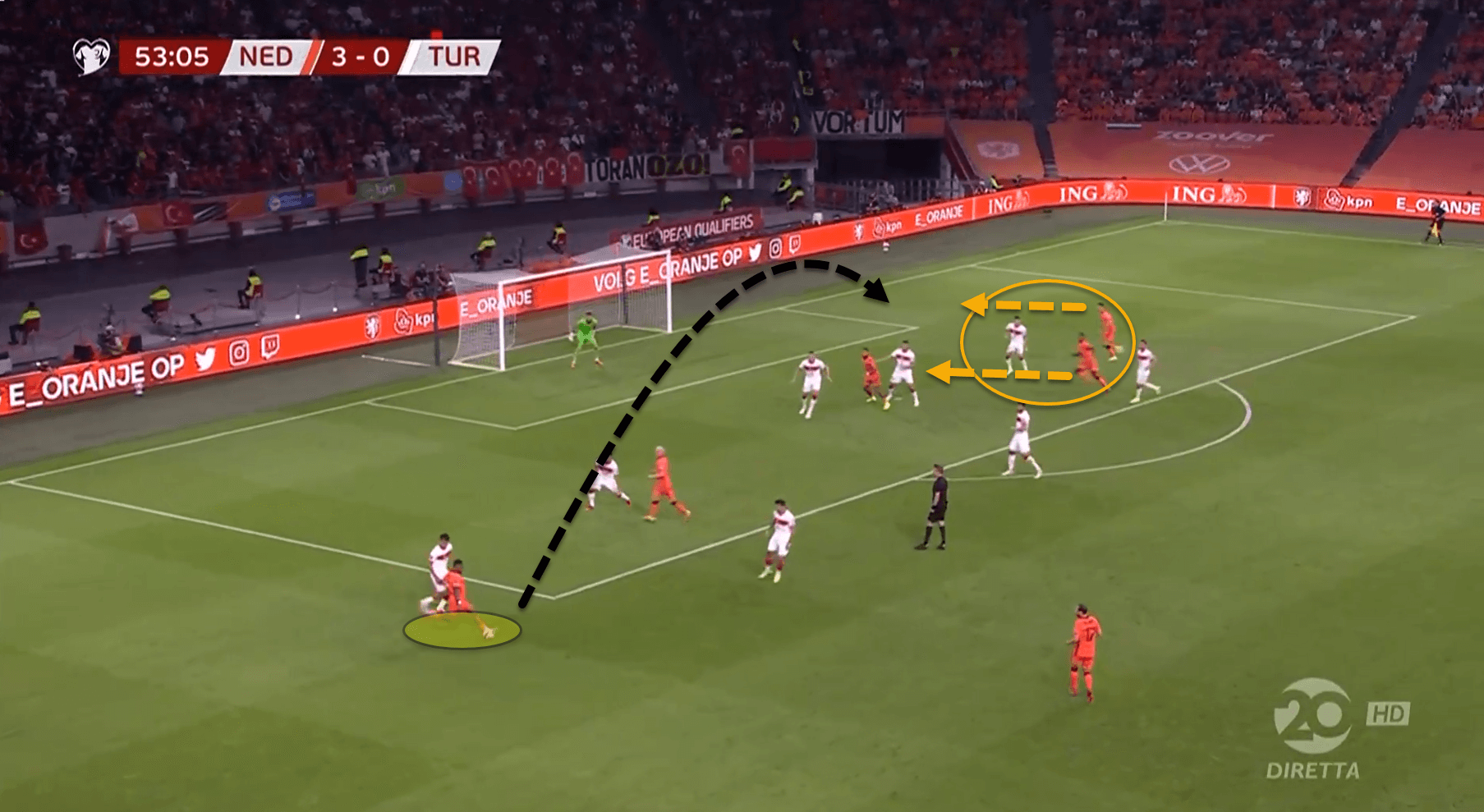
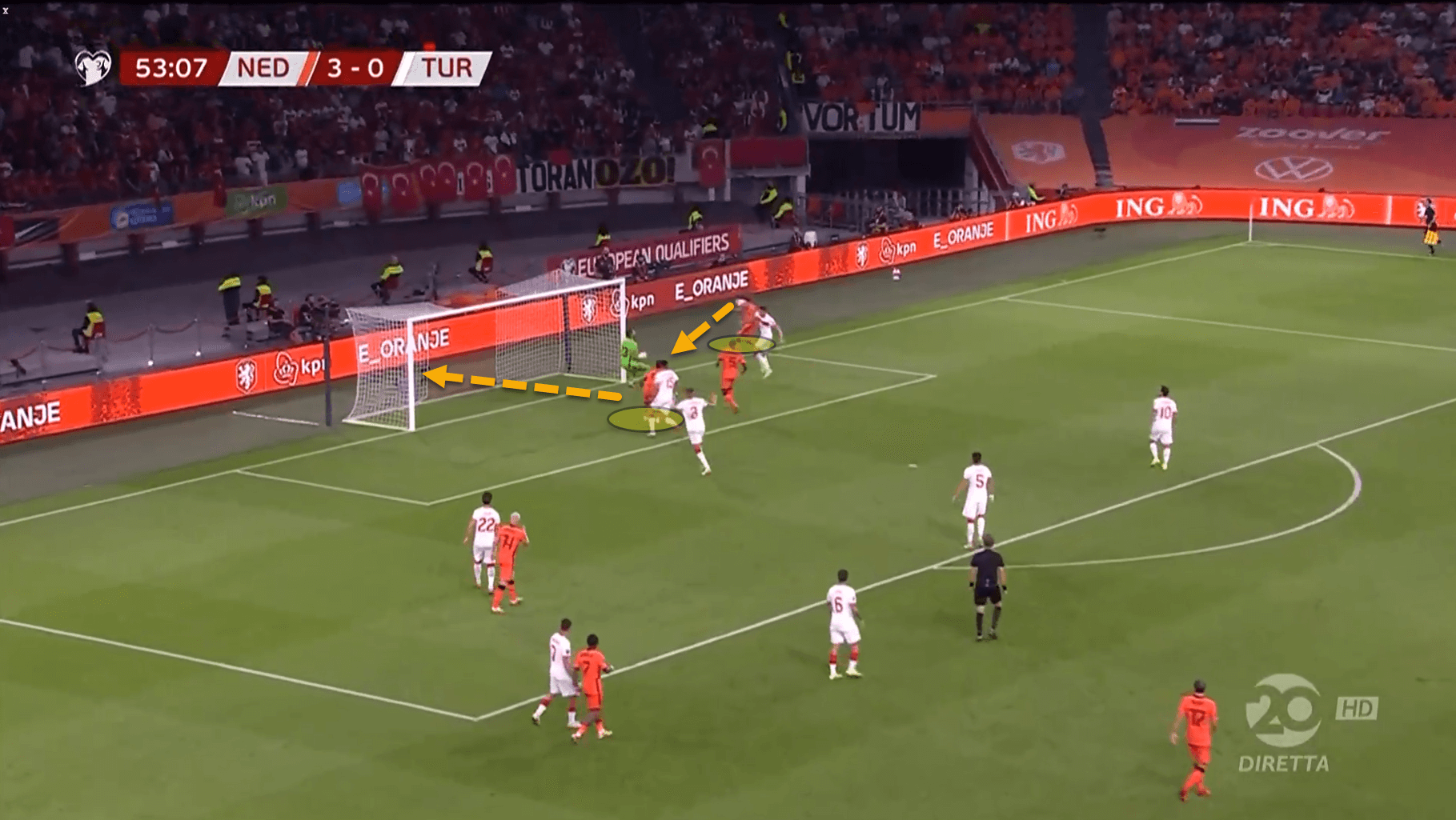
Conclusion
Following his rather unsuccessful spell in England, despite winning an FA Cup in 2016 with Manchester United, van Gaal earned himself a reputation for playing a conservative and uninspiring possession style of football.
However, this Dutch team is anything but, particularly in the last two games against Turkey and Montenegro where they scored a total of ten goals. The Netherlands have been electric under the legendary manager and are now in pole position to top the group and to qualify for the World Cup in Qatar 2022.
Perhaps next year, under van Gaal, the Netherlands could potentially win their first-ever World Cup.





Comments